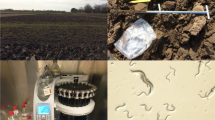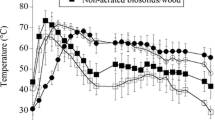Abstract
Biological degradation rates of six pharmaceuticals and personal care products were examined in soil from a land application site and in adjacent soil with no prior history of effluent exposure. Microbial degradation rates were compared over 2 weeks under standing water or saturated conditions and draining conditions after having been saturated for 3 days. Biological degradation of 17β-estradiol exhibited rapid rates of biological degradation under both saturated and draining conditions. Half-lives for 17β-estradiol ranged from 1.5 to 4 days; 66–97% was lost from the soils. Estriol showed a pattern of biological degradation in both saturated and draining conditions though the half-lives were longer (8.7–25.9 days) than those observed for 17β-estradiol. Twenty-eight percent to 73% of estriol was lost over the 14 days treatment period. Estrone and 17α-ethinylestradiol exhibited slower rates of biological transformation under saturated and draining conditions. Half-lives for estrone ranged between 27.5 and 56.8 days with loss of at most 21%. 17α-ethinylestradiol exhibited half-lives of 22.6–207 days. Half-life data for ibuprofen ranged from 30.4 to 1,706.4 days in this experiment. Losses of up to 17% were observed in draining soils. Triclosan loss was at most 10%, and half-lives were 70.9–398.8 days. In all cases, soils that were draining from saturated conditions exhibited faster degradation rates than soils that remained saturated. Prior exposure of the soil to effluent did not always result in higher biological degradation rates.






Similar content being viewed by others
References
Buser, H. R., Poiger, T., & Muller, M. D. (1999). Occurrence and environmental behavior of the chiral pharmaceutical drug ibuprofen in surface waters and in wastewater. Environmental Science & Technology, 33(15), 2529–2535.
Carr, D. L., Morse, A. M., Zak, J. C., & Anderson, T. A. (2010). Microbially mediated degradation of common pharmaceuticals and personal care products in soil under Aerobic and Anaerobic Conditions. doi:10.1007/s11270-010-0573-z.
Chen, Y., & Rosazza, J. P. N. (1994). Microbial transformation of ibuprofen by a nocardia species. Applied and Environmental Microbiology, 60, 1292–1296.
Crites, R. W., Reed, S. C., & Bastian, R. K. (2000). Land treatment systems for municipal and industrial wastes. New York: McGraw-Hill.
Daughton, C. G., & Ternes, T. A. (1999). Pharmaceuticals and personal care products in the environment: Agents of subtle change? Environmental Health Perspectives, 107, 907–938.
Golet, E. M., Xifra, I., Siegrist, H., Alder, A. C., & Giger, W. (2003). Environmental exposure assessment of fluoroquinolone antibacterial agents from sewage to soil. Environmental Science & Technology, 37(15), 3243–3249.
Jürgens, M. D., Holthaus, K. I. E., Johnson, A. C., Smith, J. J. L., Hetheridge, M., & Williams, R. J. (2002). The potential for estradiol and ethinylestradiol degradation in English rivers. Environmental Toxicology and Chemistry, 21(3), 480–488.
Kahn, B., & Lee, L. S. (2010). Soil temperature and moisture effects on the persistence of synthetic androgen 17a-trenbolone, 17b-trenbolone and trendione. Chemosphere, 79, 873–879.
Paul, E. A. (2007). Soil microbiology, ecology and biochemistry (3rd ed.). Burlington: Academic.
Sarmah, A. K., & Northcott, G. L. (2008). Laboratory degradation studies of four endocrine disruptors in two environmental media. Environmental Toxicology and Chemistry, 27, 819–827.
Xuan, R., Blassengale, A. A., & Wang, Q. (2008). Degradation of estrogenic hormones in a silt loam soil. Journal of Agricultural and Food Chemistry (ACS Publications), 56, 9152–9158.
Ying, G. G., & Kookana, R. S. (2003). Degradation of five selected endocrine-disrupting chemicals in seawater and marine sediment. Environmental Science & Technology, 37(7), 1256–1260.
Acknowledgment
This research was partially supported by the US EPA and TWRI grant no. 2009TX325B funded through the USGS 104b program.
Author information
Authors and Affiliations
Corresponding author
Rights and permissions
About this article
Cite this article
Carr, D.L., Morse, A.N., Zak, J.C. et al. Biological Degradation of Common Pharmaceuticals and Personal Care Products in Soils with High Water Content. Water Air Soil Pollut 217, 127–134 (2011). https://doi.org/10.1007/s11270-010-0573-z
Received:
Accepted:
Published:
Issue Date:
DOI: https://doi.org/10.1007/s11270-010-0573-z




